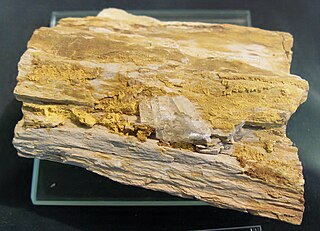
Carnotite is a potassium uranium vanadate radioactive mineral with chemical formula K2(UO2)2(VO4)2·3H2O. The water content can vary and small amounts of calcium, barium, magnesium, iron, and sodium are often present.

Descloizite is a rare mineral species consisting of basic lead and zinc vanadate, (Pb, Zn)2(OH)VO4, crystallizing in the orthorhombic crystal system and isomorphous with olivenite. Appreciable gallium and germanium may also be incorporated into the crystal structure.
Geigerite is a mineral, a complex hydrous manganese arsenate with formula: Mn5(AsO3OH)2(AsO4)2·10H2O. It forms triclinic pinacoidal, vitreous, colorless to red to brown crystals. It has a Mohs hardness of 3 and a specific gravity of 3.05.
Lyonsite (Cu3Fe+34(VO4)6) is a rare black vanadate mineral that is opaque with a metallic lustre. It crystallizes in the orthorhombic crystal system. Lyonsite often occurs as small tabular typically well formed crystals. Lyonsite has a good cleavage and a dark gray streak.

Wakefieldite is an uncommon rare-earth element vanadate mineral. There are four main types described of wakefieldite- wakefieldite-(La), wakefieldite-(Ce), wakefieldite-(Nd), and wakefieldite-(Y), depending upon the dominant rare-earth metal ion present. Wakefieldite has a Mohs hardness ranging from 4 to 5. Wakefieldite forms crystals of tetragonal structure. In terms of crystal structure, it is the vanadate analog of the rare-earth phosphate mineral xenotime. Unlike xenotime, it is more favorable for wakefieldite to contain the lighter rare-earth elements over the heavier ones. Due to the lanthanide contraction, the heavier rare earths have smaller ionic radii than the lighter ones. When the phosphate anion is replaced by the larger vanadate anion, the tetragonal crystal system preferentially accommodates the larger light rare-earth elements.
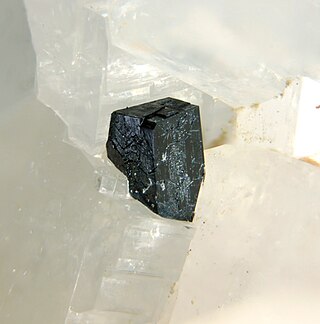
Wakefieldite-(Ce) is the cerium analogue of the uncommon rare-earth element vanadate mineral Wakefieldite. It is a member of the xenotime group.

Wakefieldite-(La) is the lanthanum analogue of the uncommon rare-earth element vanadate mineral Wakefieldite. It is a member of the xenotime group.
Wakefieldite-(Nd) is the neodymium analogue of the uncommon rare-earth element vanadate mineral wakefieldite. It is a member of the xenotime group.
Schäferite is a rare vanadate mineral with chemical formula Ca2NaMg2[VO4]3. Schäferite is isometric, which means that it has three axes of equal length and 90° angles between the axes. Schäferite is isotropic, meaning that the velocity of light is the same no matter which direction the light passes through.
Gatehouseite is a manganese hydroxy phosphate mineral with formula Mn5(PO4)2(OH)4. First discovered in 1987, it was identified as a new mineral species in 1992 and named for Bryan M. K. C. Gatehouse (born 1932). As of 2012, it is known from only one mine in South Australia.
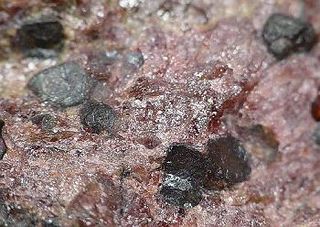
Sonolite is a mineral with formula Mn9(SiO4)4(OH,F)2. The mineral was discovered in 1960 in the Sono mine in Kyoto Prefecture, Japan. In 1963, it was identified as a new mineral and named after the Sono mine.

Tangeite, also known as calciovolborthite, is a calcium, copper vanadate mineral with formula: CaCu(VO4)(OH). It occurs as a secondary mineral that can be found in sandstone and also in the oxidized zones of vanadium bearing deposits.
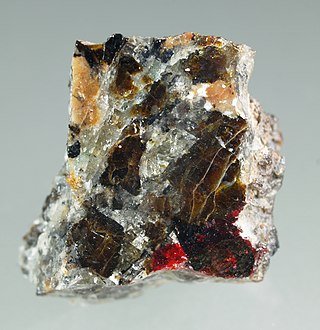
Gurimite is a rare mineral with formula Ba3(VO4)2. It is a simple barium vanadate, one of the most simple barium minerals known. It is named after its type locality - Gurim anticline in Israel. It has formed in the rocks of the Hatrurim Formation. Gurimite's stoichiometry is similar to that of copper vanadates mcbirneyite and pseudolyonsite. An example of other barium vanadate mineral is tokyoite.
Iyoite is a very rare manganese copper chloride hydroxide mineral with the formula MnCuCl(OH)3. Iyoite is a new member of the atacamite group, and it an analogue of botallackite characterized in manganese and copper ordering. Iyoite is monoclinic (space group P21/m). It is chemically similar to misakiite. Both minerals come from the Ohku mine in the Ehime prefecture, Japan.
Manganiceladonite is a rare silicate mineral with the formula KMgMn3+Si4O10(OH)2. It is one of many minerals discovered in the Cerchiara mine, La Spezia, Liguria, Italy.
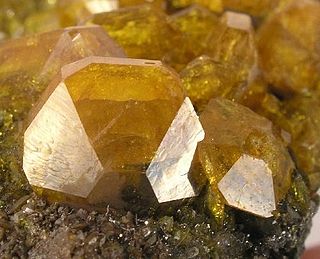
Sturmanite is a rare sulfate mineral with the chemical formula Ca6Fe3+2(SO4)2.5(B(OH)4)(OH)12 · 25 H2O. It crystallises in the tetragonal system and it has a Moh's hardness of 2.5. Sturmanite has a bright yellow to amber colour and falls in the ettringite group. It was named after Bozidar Darko Sturman (born 1937), Croatian-Canadian mineralogist and Curator Emeritus of Mineralogy, Royal Ontario Museum.

Gottlobite, CaMg(VO4,AsO4)(OH), is a mineral found as isolated crystals or isometric grains of orange or orange-brown color. The size of the crystals are a half millimeter in diameter and are part of the orthorhombic crystal system. Gottlobite forms a solid solution with adelite, which is an end member composition of CaMg(VO4)(OH), as well as being classified in the adelite group. Gottlobite is also part of the vanadates and arsenates group. With these characteristics, it is similar to the minerals tangeite and austinite by X-ray diffraction methods.
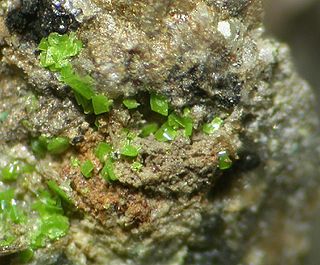
Sengierite is a rare oxide and hydroxide mineral, chemically a copper and uranyl vanadate, belonging to the carnotite group. Its chemical formula is Cu2(OH)2[UO2|VO4]2·6H2O.

Ganophyllite is a phyllosilicate mineral. It was named by Axel Hamberg in 1890 from the Greek words for leaf (φύλλον) and luster (γανωμα); the latter one was chosen due to the lustrous cleavages. The mineral was approved by the IMA in 1959, and it is a grandfathered mineral, meaning its name is still believed to refer to an existing species until this day. Tamaite is the calcium analogue, while eggletonite is the natrium analogue of said mineral.
Fianelite is a mineral belonging to the manganese vanadate category, found in iron-manganese ores. Named after the place where it was found, Fianel, a mine located in Val Ferrera, in the canton of Graubünden, Swiss. This mineral is found in small amounts in metamorphosed iron-manganese ores. This is the last crystallization of vanadate at the site since medaite was the last vanadate mineral being crystallized, but because of retrograde metamorphism, occurring at the place, vanadium moved into medaite veinlets, forming cross-cutting fianelite on medaite.











